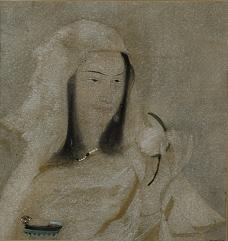 “The world speaks to me in colours, my soul answers in music.” This is a famous quote by one of India’s cult figures Rabindranath Tagore who, even seven decades after his death, remains the pride of not just Bengalis but Indians all over. Tagore songs – famously known as Rabindra Sangeet – are still popular and equally revered is his persona as an artist, but it is the art of his equally talented nephews Abanindranath Tagore and Gaganendranath Tagore that has remained largely unsung.
“The world speaks to me in colours, my soul answers in music.” This is a famous quote by one of India’s cult figures Rabindranath Tagore who, even seven decades after his death, remains the pride of not just Bengalis but Indians all over. Tagore songs – famously known as Rabindra Sangeet – are still popular and equally revered is his persona as an artist, but it is the art of his equally talented nephews Abanindranath Tagore and Gaganendranath Tagore that has remained largely unsung.
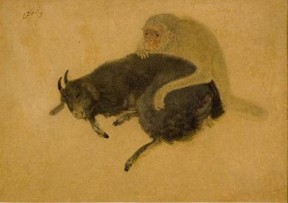 Now, in a fitting tribute to the impact of the illustrious trio on modern Indian visual culture, an exhibition titled Circle of Art: The Three Tagores, as part of Rabindranath Tagore’s 150th birth anniversary celebrations, has been mounted at the National Gallery of Modern Art in New Delhi. While over 200 works by the three masters of Bengal School ‑ who along with Raja Ravi Varma, Nandalal Bose, Amrita Sher-Gil and Sailoz Mukherjea figure in the list of India’s national treasures – have been part of the NGMA collection since late 50s, it is this tenderly curated show by Ella Dutta, a Tagore National Research Fellow at NGMA, that puts back the spotlight on their individual styles and their search for a new visual language in the backdrop of a growing nationalist movement of pre-Independence.
Now, in a fitting tribute to the impact of the illustrious trio on modern Indian visual culture, an exhibition titled Circle of Art: The Three Tagores, as part of Rabindranath Tagore’s 150th birth anniversary celebrations, has been mounted at the National Gallery of Modern Art in New Delhi. While over 200 works by the three masters of Bengal School ‑ who along with Raja Ravi Varma, Nandalal Bose, Amrita Sher-Gil and Sailoz Mukherjea figure in the list of India’s national treasures – have been part of the NGMA collection since late 50s, it is this tenderly curated show by Ella Dutta, a Tagore National Research Fellow at NGMA, that puts back the spotlight on their individual styles and their search for a new visual language in the backdrop of a growing nationalist movement of pre-Independence.
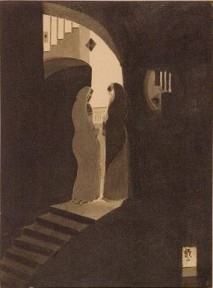 Says Ella Datta: “What prompted us to mount this exhibition was the need to highlight the creative milieu that nurtured the three geniuses. NGMA has an admirable collection of works by the three artists but how many people have seen these works?”
Says Ella Datta: “What prompted us to mount this exhibition was the need to highlight the creative milieu that nurtured the three geniuses. NGMA has an admirable collection of works by the three artists but how many people have seen these works?”
It took over six months for Datta to select the 111 works that are now on display in different sections – portraits and head studies, landscapes, animals, theatre and fantasy – while choosing evocative text from books written on the artists, famous quotes by well-known people on the pioneers and rare photographs that add admirably to the show.
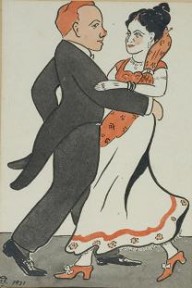 The curator has made sure that some of the rarely seen masterpieces by the three Tagores are part of the exhibit – the section devoted to portraits and head studies being the most fascinating of the lot. Looking at Rabindranath’s dark, brooding head studies of unknown faces “that he mostly painted out of imagination with rhythmic brush strokes that are strong and intense,” it is hard to believe that he had no formal training in art. “And yet he created such powerful imagery in merely coloured ink,” says Datta, “Abanindranath’s style is more subtle and softer.”
The curator has made sure that some of the rarely seen masterpieces by the three Tagores are part of the exhibit – the section devoted to portraits and head studies being the most fascinating of the lot. Looking at Rabindranath’s dark, brooding head studies of unknown faces “that he mostly painted out of imagination with rhythmic brush strokes that are strong and intense,” it is hard to believe that he had no formal training in art. “And yet he created such powerful imagery in merely coloured ink,” says Datta, “Abanindranath’s style is more subtle and softer.”
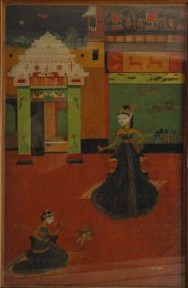 In fact, it is Abanindranath’s delicate studies of family members, of a young Mahatma Gandhi, and even of his uncle Rabindranath dressed as a baul singer that brings into light his comfort with the miniature style of Mughal art. At the time Rabindranath blossomed as an artist to reckon with in 1928 – painting images laden with memory and fantasy and using every available paper in coloured ink, crayon and gouache with frenzy – Abanindranath was already a well-established painter and writer. Unlike his uncle and elder brother Gaganendranath, Abanindranath had formal training in art from Olinto Ghilardi and Charles Palmer, but was instinctively drawn towards the delicacy and subtlety of Mughal miniatures and to the wash and calligraphy technique that he learned from visiting Japanese artists.
In fact, it is Abanindranath’s delicate studies of family members, of a young Mahatma Gandhi, and even of his uncle Rabindranath dressed as a baul singer that brings into light his comfort with the miniature style of Mughal art. At the time Rabindranath blossomed as an artist to reckon with in 1928 – painting images laden with memory and fantasy and using every available paper in coloured ink, crayon and gouache with frenzy – Abanindranath was already a well-established painter and writer. Unlike his uncle and elder brother Gaganendranath, Abanindranath had formal training in art from Olinto Ghilardi and Charles Palmer, but was instinctively drawn towards the delicacy and subtlety of Mughal miniatures and to the wash and calligraphy technique that he learned from visiting Japanese artists.
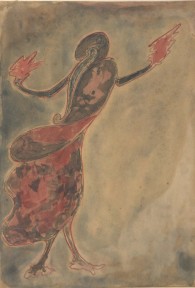 Gaganendranath, on the other hand, painted for his own pleasure and attempted a wide range of subjects, from satirical caricatures of the society of his times that was changing under a western influence, theatre sets that he designed for uncle Rabindranath’s plays, and the mischief created by light and shade. Some works that stand out for the playfulness with which Gaganendranath approaches his subjects are Ball Room Dance (ink and watercolour on paper) and Chemical Scream: Out Damned Spot Out I Say, the latter being a cartoon of a Bengali chemist trying to work with a special ink.
Gaganendranath, on the other hand, painted for his own pleasure and attempted a wide range of subjects, from satirical caricatures of the society of his times that was changing under a western influence, theatre sets that he designed for uncle Rabindranath’s plays, and the mischief created by light and shade. Some works that stand out for the playfulness with which Gaganendranath approaches his subjects are Ball Room Dance (ink and watercolour on paper) and Chemical Scream: Out Damned Spot Out I Say, the latter being a cartoon of a Bengali chemist trying to work with a special ink.
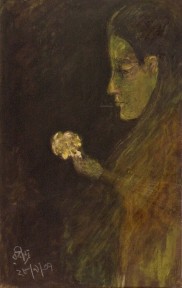 The technique of photography, in fact, is most evident in Gaganendranath’s semi-abstract, geometric work of a “seemingly cubist nature”, especially in those paintings inspired by their famous house in Jorsanko, North Calcutta – now a museum and gallery – which was a melting pot of creativity, every member of the large joint family being involved in literature, philosophy, music, dance and visual arts. A few portions of the house, mainly the staircase and the rooftop, also emerge in some of his paintings like Twilight and Meeting At The Staircase.
The technique of photography, in fact, is most evident in Gaganendranath’s semi-abstract, geometric work of a “seemingly cubist nature”, especially in those paintings inspired by their famous house in Jorsanko, North Calcutta – now a museum and gallery – which was a melting pot of creativity, every member of the large joint family being involved in literature, philosophy, music, dance and visual arts. A few portions of the house, mainly the staircase and the rooftop, also emerge in some of his paintings like Twilight and Meeting At The Staircase.
“It is because of this influence that I decided to put up the photographs of the house as well. The house played an important part in their lives,” says Datta.
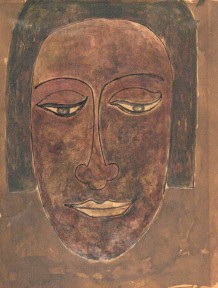 Interestingly, although the three Tagores were open to influences of other art traditions – in one of Rabindaranth’s work titled Vase, one can see a Chinese influence of totemic, primitive art – they were rooted to their own culture. Each one of them had an individual style of expression but certain common threads seem to bind their work, for instance, fantasy and deep romanticism. All three have painted landscapes, but while Rabindranath painted landscapes of the mind, the two nephews had some reference to a real place that they had seen.
Interestingly, although the three Tagores were open to influences of other art traditions – in one of Rabindaranth’s work titled Vase, one can see a Chinese influence of totemic, primitive art – they were rooted to their own culture. Each one of them had an individual style of expression but certain common threads seem to bind their work, for instance, fantasy and deep romanticism. All three have painted landscapes, but while Rabindranath painted landscapes of the mind, the two nephews had some reference to a real place that they had seen.
The section on landscapes begins with a black-and-white photograph by Shambhu Saha titled Sal Bithi that shows an open air class amidst towering sal trees. “While one cannot make out who the teacher is, it could be Rabindranath Tagore. I chose this picture to establish the environment in which these works were created,” says Datta.
Vast green fields, scenes from the rainy season, open blue skies, moonlit nights and mist-covered mountains – all form part of this section. In the section dedicated to fantasy and animal studies, the three Tagores have explored what the subconscious mind can create – a complex web of simple details.
Circle of Art: The Three Tagores is on at NGMA, New Delhi till June 15, 2011. Also, on May 18, at 6:30 p.m., Sudhir Kakar, psychoanalyst and writer, will deliver a talk on the subconscious in the paintings of Rabindranath Tagore.
Poonam Goel is a freelance journalist and has covered the arts for over 15 years. She contributes on visual arts for various newspapers, magazines and online media. More about her on Story Wallahs. Write to her @ poonamgoel2410@gmail.com





